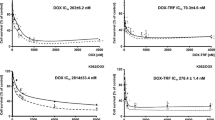Abstract
Several Methotrexate (MTX)-resistant sublines of the osteogenic sarcoma cell line 791T were derived by continuous selection in the presence of MTX and 12-O-tetradecanoylphorbol-13-acetate (TPA). Studies including assays of the uptake and binding of [3H]MTX and fluoresceinated-MTX, determined that these sublines showed diminished MTX transport, and that none of them appeared to overproduce the MTX-target enzyme dihydrofolate reductase. Conjugates of the anti-791T monoclonal antibody 791T/36 linked to MTX via human serum albumin (HSA) were prepared by Dr M.C. Garnett. These were cytotoxic selectively for cells bearing the 791T/36-defined antigen (gp72), and were found to be as cytotoxic to most of the MTX-resistant 791T sublines as they were to parental 791T cells. Furthermore, an anti-MTX/anti-gp72 bispecific antibody 516 augmented the cytotoxicity of HSA-MTX conjugate to the MTX-resistant 791T variant R120 apparently as efficiently as for parental 791T cells. It is suggested that acquired drug resistance caused by deficient transport mechanisms may be partially or wholly overcome by targeting the drug to a readily-internalised cell surface antigen.
Similar content being viewed by others
Author information
Authors and Affiliations
Rights and permissions
About this article
Cite this article
Affleck, K., Embleton, M. Monoclonal antibody targeting of methotrexate (MTX) against MTX-resistant tumour cell lines. Br J Cancer 65, 838–844 (1992). https://doi.org/10.1038/bjc.1992.178
Issue Date:
DOI: https://doi.org/10.1038/bjc.1992.178
- Springer Nature Limited




